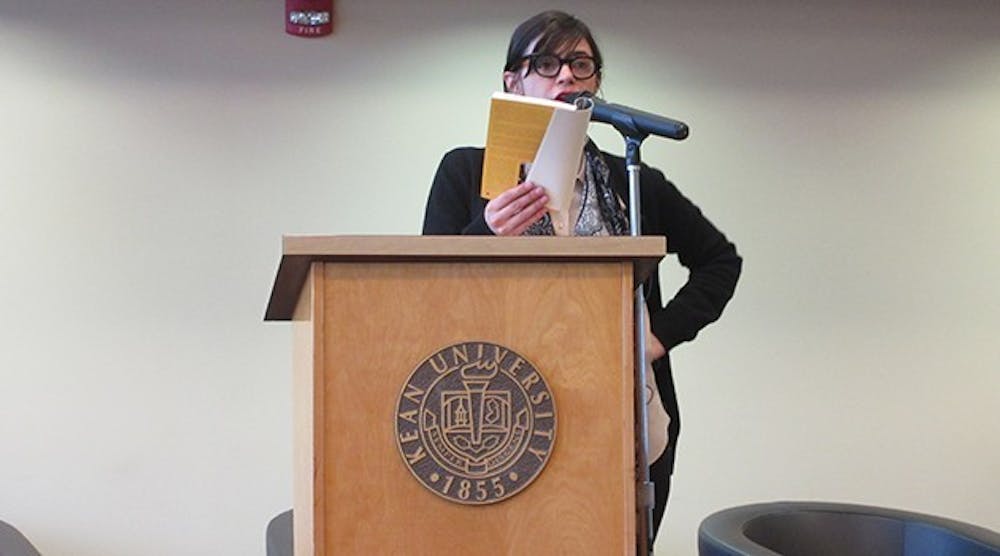Author Valeria Luiselli reads her book Faces in the Crowd
Photo Credit: Aliyah Price-Perry l The Cougar's Byte
On March 4, 2015, from 4:30 p.m. to 6:00 p.m., students gathered on East Campus, located at 215 North Avenue in Hillside New Jersey [NJ], to listen to the book reading of Valeria Luiselli’s Faces in the Crowd.
Luiselli is a notable author whose works have gained her considerable attention. Separately, she is currently a doctoral student at Columbia, the wife of an established author, and a mother. She was recognized by the National Book Foundation as one of the five most talented writers under the age of 35 and her work has been translated in more than 13 languages. While Luiselli is currently settled in New York, she has spent a significant part of her childhood in various parts of the world. She began moving between countries from an early age, becoming familiar with multiple cultures and fluent in numerous languages. While she has never lived anywhere for longer than 3-4 years or in the same home for 2 or more years, each place has played a role in shaping the author she is today. She states, “the different places I've lived are important for different reasons...every space has given me something different and I cherish all of those things…” While she spent her early years in Mexico City, places like South Korea and Africa molded her throughout her youth. In South Korea she learned to read and write and in Africa, because of the peculiar political circumstances of the time, she became socially conscious. In many ways, her diverse character appears in her writing. She states “...And I guess it reflects in many levels in what I write. One possible level is that my books tend to not stay in one particular narrative viewpoint, but shift around constantly and are often conscious of that shifting.”
Writing has been a tremendous aspect of her life; she considers it to be a medium of self-expression that allows people to live many lives. “I think that we all have the freedom to reinvent ourselves...writing particularly is an activity that lets you reinvent yourself all the time, you are all the people and all the voices you choose to inhabit.” She frequently refers to reading as a conversation, and writing as a dialogue with what one has been reading. Luiselli states, “When I started collecting literature I wanted to produce what others’ writing had produced in me. Later on, in my teenage years, reading produced things in me that nothing else did. It gave me a language to understand things.”
When she began to conceive her novel, she was reading various modernist poets such as Ezra Pound and Emily Dickinson. The title is inspired by a poem written by Pound, Station of the Metro. Pound penned the poem after an interesting encounter in a subway station. As the story goes, he had lost a dear friend, Henry, to the war. One day while standing in the subway, the door opened and he saw, among the trickling crowd, a brief glimpse of Henry. Despite his certainty that his friend had passed, the moment felt real to him. Consequently, he wrote a 300 verse poem about this non-encounter. Upon reflection, he realized that lengthy expose in no way captured the moment, the fleetingness of the instance had to be reflected in the poem, and so he began cutting lines. His finished product was only two lines: “The apparition of these faces in the crowd; Petals on a wet, black bough.” While it doesn’t exactly establish an analogy, the poem somehow creates an equation between faces in the crowd and pets on a flower.
Inspired by this, Luiselli wrote Faces in the Crowd. She became enamored with the strange fleeting intimacy of the instance when two trains whizzed by one another and an individual is bombarded with the sensation that they are peering into another person’s life. Luiselli states, “It doesn’t happen very often in the city. And when it happens, I stop, as if I am watching a brief innocent movie. I always ask myself what is this like?” Pound’s understanding of images was unrelated to symbols and metaphors. Instead, he preferred the idea of an image as an emotional and intellectual complex that doesn’t necessarily represent anything else but itself, something that condenses an idea but also a set of emotions. In her early 20s, Luiselli was enamored by images, poetry, and the ideas behind these two concepts.
Luiselli goes on to read the first few pages of her novel to the audience. The novel was beautifully crafted in a way that captivated the audience as she read. She states, “I like to think of my work as something that sort of bears the imprint of what happened while it was being made, so all that is kind of there, it picks up the rubbish. But I’m also very aware of how every word that I use or image that use has a specific gravity.” Throughout the novel, the narrator shifts back and forth between her present and her past and later on, a second narrator is introduced. Among other things, Luiselli pays particular attention to architecture and cartography. The setting of the book is divided into three settings. She states, “New York is almost like a character in the book. Mexico City is kind of present in its absences. Philadelphia is kind of an imagined territory...”
Her work has taken her into many directions, the most recent being cinema. Recently a film producer requested rights, and since then she has written another novel entitled The Story of my Teeth, which was written in installments for workers in a juice factory. Luiselli’s success can be attributed to a number of contributors, most importantly her passion and individuality. She exists in a category all her own and that makes her work invaluable. She simply states, “They’re not easily placed in a cultural niche. I think what happens in the book market itself is people will always want to place you in a pigeonhole, put you in a box, but my work is difficult to label.”



